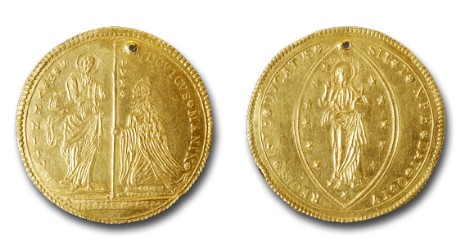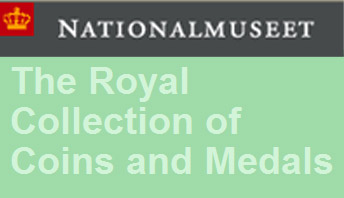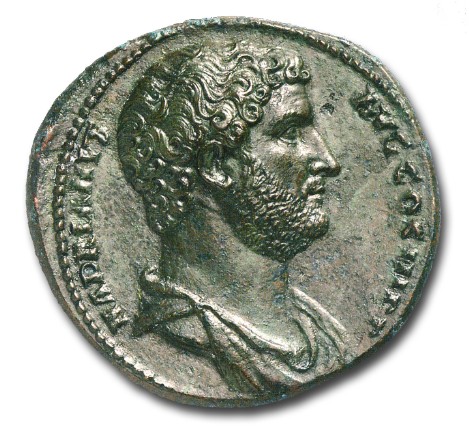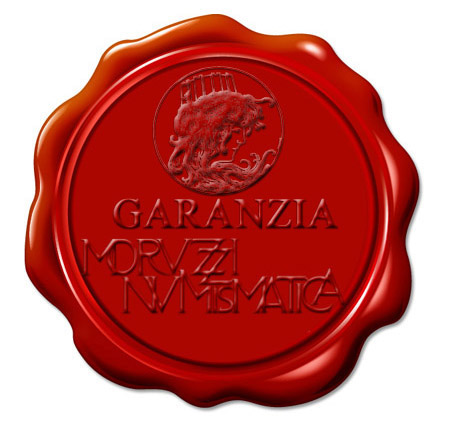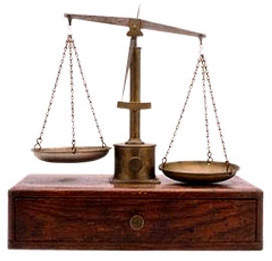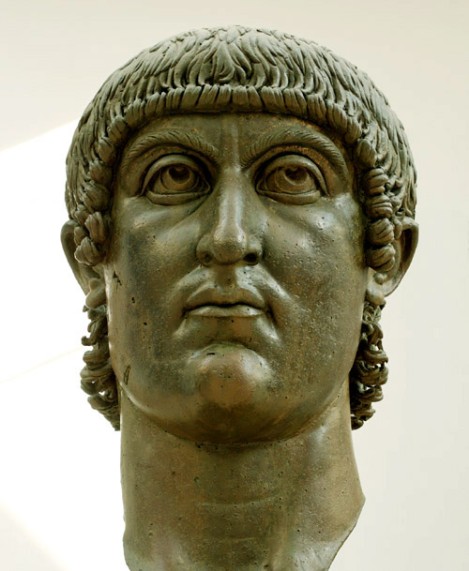FAQ - Frequent Asked Questions - Moruzzi Numismatica Roma
Main menu:
FAQ - Frequent Asked Questions
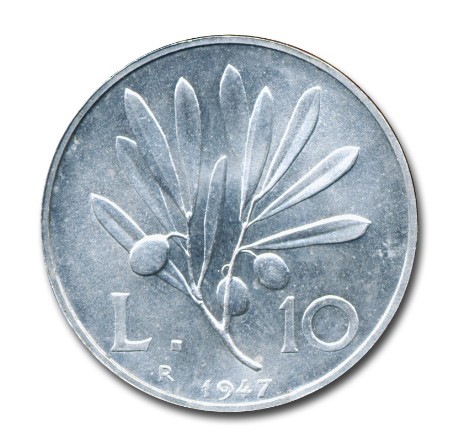
Which are the Italian republican lire with a numismatic value?
The rare coins issued in Italy since 1946 are lira, two, five and ten lire minted in 1946 and 1947, two lire in 1958 and five lire in 1956. To establish the value of a coin it's very important that the coins have a good state of preservation. In fact scratches, strokes, wear and metallic concretions affect significantly their value. We also indicate the 100 lire coin of 1955 and the 50 lire of 1958: in this case it's important, however, that the coins have a perfect state of preservation, otherwise they will lose significantly their value.
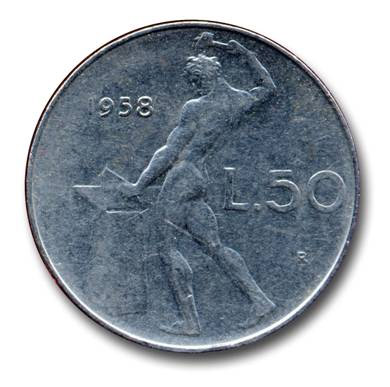
Is the 50 lire coin of 1958 rare?
The 50 lire coins of 1958 are considered modestly rare and, despite the print run of 825.000 copies, they aren't easily available. There is a numismatic interest for this coin at all degrees of conservation. The value goes from 20 to 2000 euros for the copies newly minted!
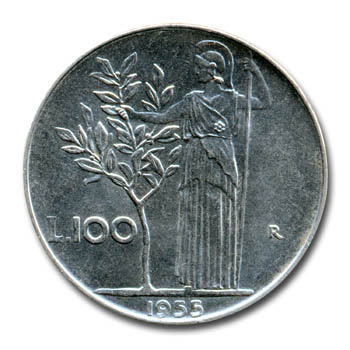
Is the 100 lire coin of 1955 rare?
The 100 lire coins of 1955 aren't considered rare, due to the print run of 8 million six hundred thousand . The numismatic interest for this coin counts only for the copies in state of newly minted preservation. They are really difficult to find. In this case the commercial value can reach around 1200 euros.
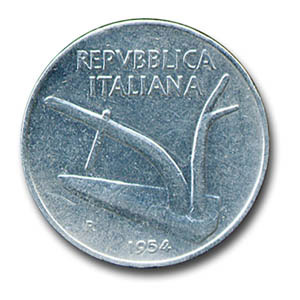
How much is the 10 lire of 1954 worth?
The 10 lire coins of 1954 are common coins minted in 95.250.000 copies. The interest for this coin counts only for the copies in state of newly minted conservation and its value is around 70 euros.
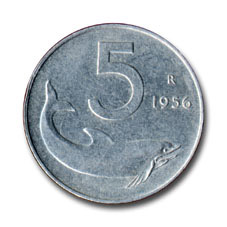
How much is the 5 lire coin of 1956 worth?
The limited print run of the 5 lire of 1956 (only 400.000 copies) makes these issues fairly rare. These small coins have a value of 50 euros even in a not good state of preservation. The value in state of newly minted conservation is instead conspicuous, about 1500 euros!
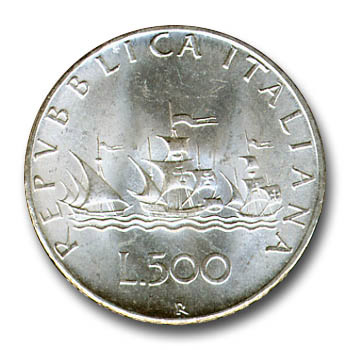
How much are the 500 lire "Caravels" and the other silver 500 lire worth?
The 500 lire in silver of the Italian Republic are in general very common and their value (despite the fact that they circulated for a short time) is about 2 euros. If you want to see the value of the copies in state of newly minted conservation, visit our store. If you want to sell them, please contact us. Among these, the only rare coin is the "Caravels" with the "overturned flags". You can identified it by the word "PROVA" written on the reverse. You can also recognized it from the flags moving in the opposite direction to the wind and from the year of issue, 1957, which is clearly visible on the edge of the coin.
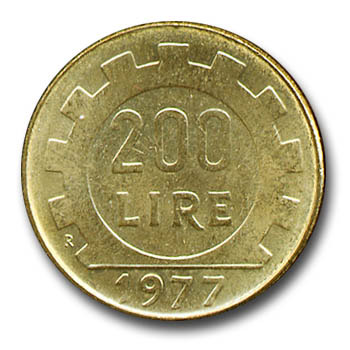
Is true that the 200 lire of 1977 are a coin of great numismatic value?
In 1977 the 200 lire coin of "work" type was started to be minted. The first copies, minted in this year and identified by the word "PROVA" on the reverse, are really rare. The other copies with the same date, produced in 15.900.000 units, don't have any value. So the high numismatic value of the 200 lire coin - 1977 is just an urban legend. For many years in the newspapers ,in the economic advertisements sections, appeared insertions in which the coin was sold at high price; this fact built in people the opinion that this coin was a rare type.
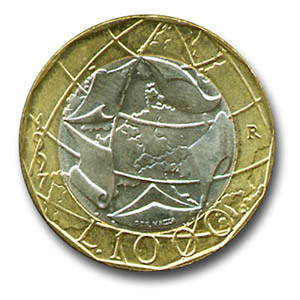
I would like to know the value of the bimetallic 1000 lire with the wrong borders of Germany.
It's a very common coin, minted in hundred million copies and never withdrawn from circulation ; it hasn't any numismatic interest. The first issue of this coin had on the reverse a wrong map of Europe: borders of Holland, Denmark and Luxemburg were wrong and there wasn't the ex-German Democratic Republic. In a later version instead Germany is reunited and the borders of Holland and Luxemburg are correctly defined. The position of Denmark isn't correct yet. In this case, the mint of Rome made a poor showing.
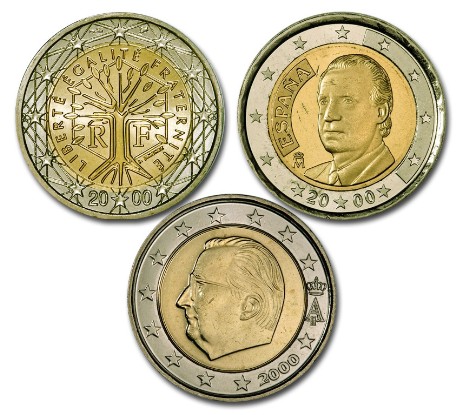
I found an euro coin with a date prior to 2002. How is it possible?
All European countries that agreed to the single coin, minted coins from 1 cent to 2 euros from 1999 to 2001. These coins were distributed since December the 15th 2001 and they began currency since January the 1st 2002. In the matter of the date written on the coins, the different European countries choose - to be honest - in absolute freedom. While Italy, Germany, Portugal and Luxemburg minted coins from the year 2002, other countries choose to put on their issues the real date of minting. So it isn't unusual to find French, Spanish, Finnish or Belgian coins of the 1999, 2000 and 2001 years.
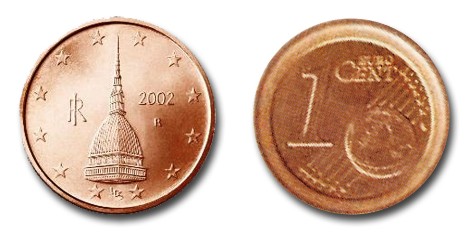
I have got euro coins that are different from the currency ones. How much are they worth?
Since the introduction of the euro, many coins "weird" appeared as currency. They were different compared to the currency in appearance, metal and other characteristics. At first sight, they might be false coins that circulate profusely in Euroland. They could also be coins with defects or variants really issued by the European mints. In the matter of the coins minted in Italy, at the mint of Rome, their circulation isn't authorized and their emission can be illegal. In this case these copies aren't collectible. Anyway this is just a curiosity and these coins haven't any numismatic value. Among these the so-called "Mole Cent" is the best known. Even if it has the same size of the 2 cents coin and the image of the Mole Antonelliana, it presents on the other side the value of a 1 cent. Q.V. Stato e Collezionismo, indagine sulla numismatica - Domenico Luppino, 2009, Eupremio Montenegro Editore.
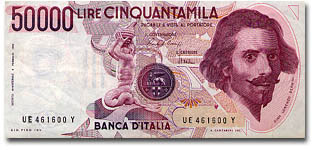
Is true that there are some notes of 50.000 lire with a high numismatic value?
A significant numismatic value is attributed to the Bernini 50.000 lire, the ones of the first kind with the series letters XE or E as second letter of the serial number. To clarify the matter it is the kind already out of circulation from 1996. They have the date of the Ministerial Decree 02.06.1984 that precedes of two months the new note. The substantial differences between the first and the second "Bernini" kind concerns the chromatic choices of the notes. The first kind bears the numerical values in colour gradation that comes from red-purple to blue. The second kind bears the value of the obverse in green and the value of the reverse in burgundy.
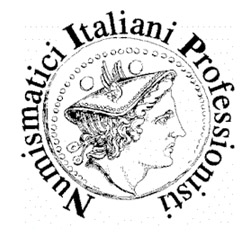
I have some coins and I would like to know their value
It's possible to turn to numismatic experts who can provide appropriate surveys and certifications of coins with numismatic value.
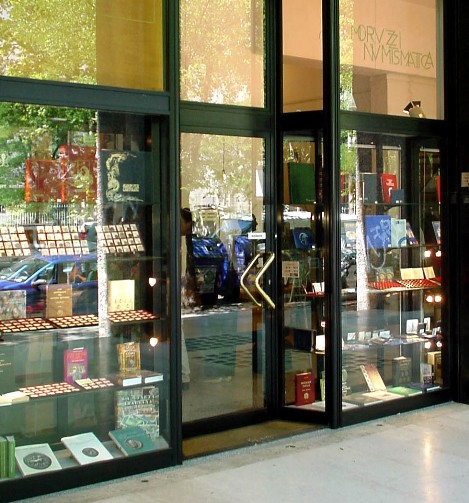
I have a numismatic collection to sell. Who should I refer to?
Read our page on how to sell. You can contact our experts by phone or by e-mail; if you come to visit us, have a look on where we are.
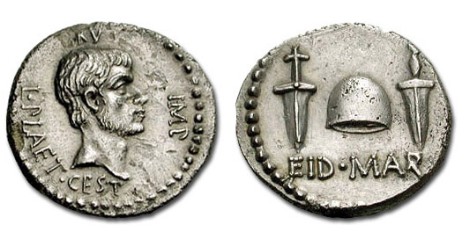
Which is the best known coin?
There are many evocative coins, but among these we can certainly mention the Denarius of Brutus - Caesar's murderer - that represents on the obverse the Brutus portrait and on the reverse the pileus (hat symbol of freedom) between two daggers with the legend EID MAR to commemorate the Caesar's killing which took place on the day of the Ides of March in 44 B.C. The message remained alive over the centuries. In fact in the modern age, the Dioscuri hat was adopted as symbol of freedom during the French Revolution.
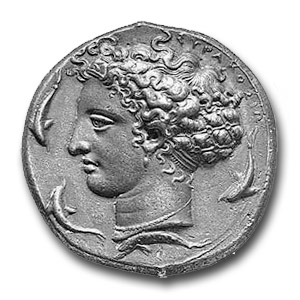
Who were the authors of the most important coins?
We must go back to 2500 years ago - more or less - mentioning the work of some extraordinary Greek engravers such as Cimon, Eukleidas and Eveneto. They lived and worked in Syracuse at the end of the fifth century B.C., signed with their own name the famous silver dekadrachms and tetradrachms. In the modern age, instead, famous artists of Renaissance and of post-Renaissance period, mostly Italian, realized drawings and models of coins and medals of high artistic value. Among these we can mention Antonio Pisano, called Pisanello - who created models of medal-portraits representing characters of his time; Benvenuto Cellini - engraver of cones and papal and medicean coins - and Leone Leoni, who worked as engraver both for the papal mint and for the Milan one. In more recent times, Benedetto Pistrucci, another Italian, was the creator of the beautiful coin on the reverse with St. George slaying the dragon - which since more than 150 years characterizes the English gold sterling - and of other coins.
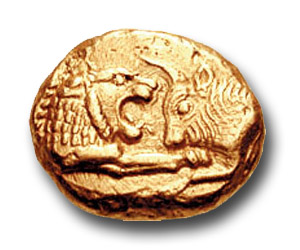
Where and in which century were minted the first coins?
For a long period the economy was based exclusively on barter (exchange of natural or processed products and livestock) and on the exchange of metals, mostly precious. After that was created the monetary system for practical needs. At the beginning of the sixth century B.C., the Greeks of Ionia in Asia started to mint the first coins using the electro, a natural alloy of gold and silver, widely available in those regions of Asia Minor.
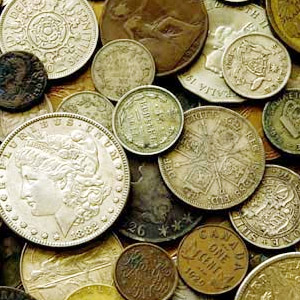
Does it take significant financial resources to become a collector?
Not always. It depends obviously on what kind of the collection do you want to realize. It's possible to put together a collection of coins based on different selection criteria, but the choice is a personal affair. Even if the price of a collection coin raises thanks to a well-defined parameters (such as the rarity, the excellent style, the high state of preservation, the beautiful patina, etc.), it's true that it is possible to buy, for example, old coins (Greek and Romans) with altogether pleasant aspect, spending amounts really contained (sometimes even few euro). Without making excessive sacrifices, it's possible to satisfy the desire of be an owner of a small piece of our past.
How heavy was the biggest European coin really issued into circulation?
In modern age, referring to Europe, among the coins that really circulated we can mention one whose weight exceeds 350 grams. It is a gold coin, a multiple of 105 sequins, issued by the Venice mint under the Doge Ludovico Manin (1789-1797), on which appears the traditional iconography of the Doge kneeling in front of St. Mark and of Blessing Christ contained in a stars almond. Changing continent, we have to remember also some really special coins, not only for their significant weight, but especially for their shape really unusual. We are talking about bronze and silver copies with the shape of a sword, a hoe and a star circulating in China until the 1930s.
Which is the smallest coin ever realized?
In ancient Greece there were many small coins whose weight was from few tenths to few hundredths of grams. An example? The sets of little silver coins (emilitra) minted between the end of the VI century and the first half of the V century B.C. by the Taranto mint, with marine inspired types (shell/Nymph's head). We can also instance a silver copy of uncertain denomination minted in Sicily by the Massana mint. On the coin appears a ram's head with the monogram of the city. The coin is now preserved at the Danish National Museum of Copenhagen in Denmark: its weight is only 0,06 grams!
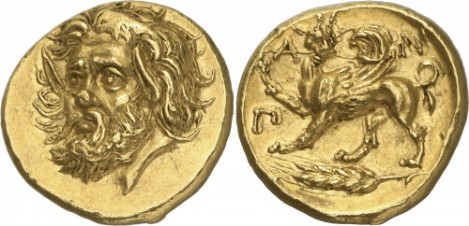
Qual è la moneta antica più costosa?
Which is the most expensive old coin?
Until recently, among the old coins, the most expensive was the Constantine the Great gold multiple. Known in a single copy from the famous treasure of Arras (found in 1920 in the homonymous place on the border between Belgium and France), the coin was bought in 2002 by a private collector during the auction of the Numismatica Ars Classica no.24 for the considerable amount of 800.000 Swiss francs (approximately 550.000 euros). It became part of some of the most important numismatic collections. Today the multiple of Constantine the I gave up the primacy to a sestertius of Hadrian rightly considered one of the most beautiful roman coins ever minted. Auctioned at the Numismatica Genevensis in December 2008 for the amazing sum of 2 million and 300 thousand Swiss francs (approximately 1.500.000 euros!!) was probably bought by a Swiss collector.
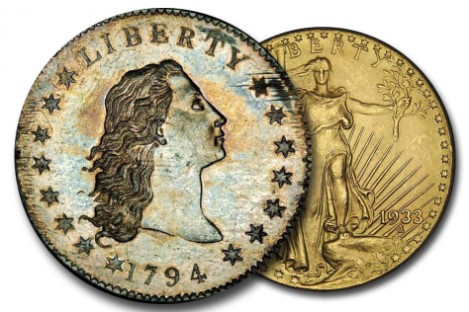
Which is the most expensive coin in the world?
It's a rare modern coin realized in the United States of America. It's a silver copy with the value of a dollar minted in 1974 and sold in June 2010 in a private transaction in United States for $ 7.850.000, approximately 6.488.000 euros. To be honest the most expensive coin would be a gold copy, from the United States, of 20 dollars minted in 1933. In July 2002 it was bought in New York at Sotheby's for 7.600.000 dollars, commissions of the auction house included (at that time approximately 7.500.000 euros).
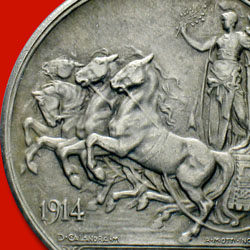
Is the sale of false coins a common phenomenon?
Yes, unfortunately. The mechanism of the false coins collection sale provides, as all the frauds, that it's possible to establish a tacit complicity between swindled and swindler. For example, if the swindled wants to buy a "fake" for a tenth of its value, he is guilty as the swindler. In the ancient polis of Sparta the law punished in the same measure both the swindled and the swindler. However, be careful, there are also clever impostors who sell false coins for real prices only with little discounts.
Are the coins bought in stores or in auction houses guaranteed as authentic?
Moruzzi Numismatica guarantees all coins for sale, with no limits in time. The serious professionals and auction houses do the same.
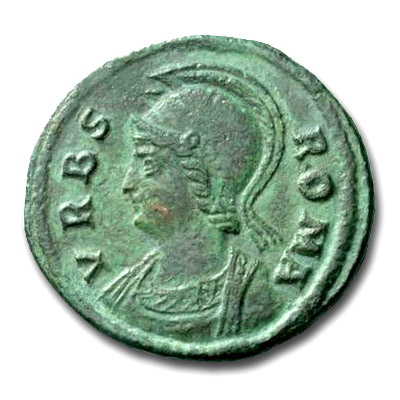
Are the old coins for sale in store simple reproductions?
Absolutely not. Each coin is investigated and analyzed and it's guaranteed as authentic with no limits in time. Q.V. the page Guarantee Moruzzi.
Is it true that the old coins should be only in museums?
The circulation and the trade of old coins is licit and permitted within the limits provided by the laws in force. To have more info Q.V the page "Collecting old coins in Italy".
Who the bronze head of your graphics belongs to?
The beautiful bronze head, roman work of the IV century A.D. , belongs to a colossal statue of the Emperor Constantine the Great. There are only two other elements of the big statue (a hand and the globe, symbol of power). Coming from the Lateran Palace, it was given to the Romans by Pope Sixtus IV in 1471 with other bronze statues. All together they formed the first nucleus of the Capitoline Museum. Today it's still possible to admire it in the same Museum, located inside the exedra created to contain the famous equestrian statue of Marcus Aurelius.
The perceived ideas of an individual are unique and a logical product of different and personal impressions. Although a great deal of intellectual comment is placed freely on the internet, it should not be forgotten that there are moral and legal obligations with respect to the plagiarising of text without the consent of the author. Copyright Moruzzi Numismatica © 1999-2016
